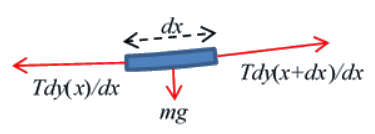1.2: A Tight String
( \newcommand{\kernel}{\mathrm{null}\,}\)
Let’s take the hint and look first at a piece of uniform string at rest under high tension between two points at the same height, so that it’s almost horizontal.

Each little bit of the string is in static equilibrium, so the forces on it balance. First, its weight acting downwards is mg=λgdx, λ being the uniform mass per unit length. Second, the tension forces at the two ends don’t quite balance because of the small change in slope.
Representing the string configuration as a curve y(x), the balance of forces gives
Tdy(x+dx)dx−Tdy(x)dx=Td2ydx2dx=λgdx
so d2y/dx2=λg/T, and y=(λg/2T)x2, taking the lowest point of the string as the origin.
So the curve is a parabola (but keep reading!).


